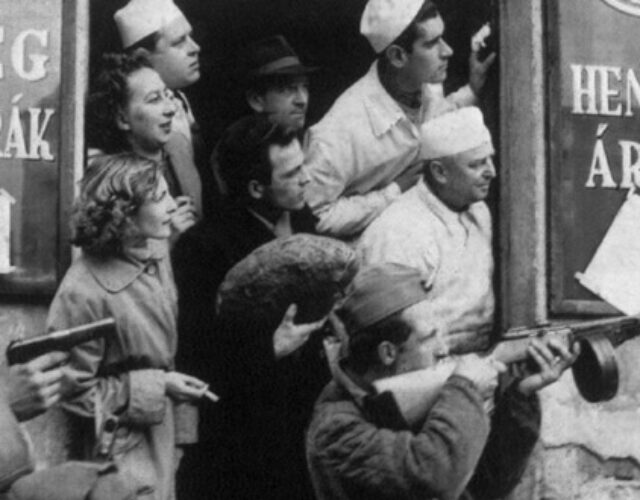Immigrants to the United States have often brought stories of escape from repression, and scientists have long been among these refugees. In the 1930s they fled the persecution of the Nazi regime. At the end of World War II a new regime rose behind the Iron Curtain in Hungary. The Science History Institute’s oral history collections hold the stories of Hungarian scientists who lived through Soviet occupation and the failed revolution of 1956.
Charles W. Tobias was conscripted into the German-allied Hungarian military in 1943. Military service was mandatory, and Tobias was lucky to be stationed near Budapest, far from the front lines. As Russian forces besieged the city in 1945, Tobias changed into civilian clothing to avoid capture and returned to his family in Budapest. The effects of war and the policies of the Soviet-installed government combined to create massive food shortages. Tobias had to scramble to find food for his mother, sick father, and disabled sister. “There were no stores,” Tobias said in his oral history interview. “Fortunately, I was clever enough to scrounge around on the black market a little bit.” Food was not the only commodity in short supply. “For a while we didn’t even have running water or gas or electricity.” Tobias, who began his doctoral work in chemistry in Budapest, managed to leave Hungary in 1947, before the government had tightened its grip on the country.
Soviet occupation also took its toll in scientific ways, said Nobel laureate George A. Olah, another Hungarian scientist interviewed by CHF’s historians. “When I started in chemistry in small, isolated Hungary, there was a very difficult problem of learning what was happening in the world. There were only a few chemistry journals available.”
Led by Soviet-backed Mátyás Rákosi, the Hungarian government began purging all opposition in 1948; by 1953 hundreds of thousands of citizens—among them many scientists and scholars—had been detained, exiled, or killed. Olah was more fortunate; his job at the Budapest Opera House gave him a measure of safety. “The Russian soldiers respected few things,” Olah said, “but being a member of the opera house was one thing that they did respect. Little did they know that my duty was to help clean rubbish and move around pianos.”
Just as things seemed bleakest, Hungarians were offered a glimmer of hope when, on March 5, 1953, Joseph Stalin died. His successor, Nikita Khrushchev, denounced Stalin’s iron-fisted policies. In 1955 Khrushchev forced out Rákosi and replaced him with a more liberal prime minister. Political prisoners were released, the economy was reformed, and writers suffered less censorship. Emboldened students across Hungary demanded more reform and were joined by workers in search of better conditions and higher pay. On October 23, 1956, a hundred thousand people marched through the streets of Budapest and toppled a statue of Stalin. A group of students attempted to broadcast their demands on Radio Budapest but were stopped by the Hungarian secret police. Fearful of the growing number of demonstrators outside the radio station, the police fired on the crowd.
Leslie L. Vadász was on the streets of Budapest during the protests and witnessed the momentous shift from peaceful demonstration to bloody revolution. In his oral history he recalled seeing “people with guns, people showing flags from the window with the Russian hammer and sickle cut out of it, and more and more evidence that there is something—there is an uprising here.” Civilians picked up guns, and hundreds of Hungarian soldiers sided with them, abandoning their posts and relinquishing their weapons to protestors. Soviet troops and tanks arrived early the next morning, gunning down hundreds of protestors-turned-soldiers. In an act of makeshift chemistry Hungarians used Molotov cocktails to disable Russian tanks in the narrow streets of the capital. By the end of the day protesters had taken over most government buildings.
“Things felt good initially,” Vadász said. “But it was obvious after a few days that it was not going to last because Russians were coming in.” On November 4 the revolution was finally crushed, and Soviet control was reinstated.
The revolution had lifted the Iron Curtain, albeit briefly, and Vadász escaped to Canada in the aftermath. He made his way to the United States in 1961 and went on to help found Intel Corporation, the world’s largest semiconductor chip maker.
Along with thousands of others, Olah also took the opportunity to flee Hungary. “There was a realization that the future was bleak,” he said. Olah moved to the United States and went on to win a Nobel Prize for stabilizing carbocations (also known as positively charged hydrocarbons). This work allowed chemists to develop more efficient fuel.
Tobias, who fled well before the events of 1956, remembered, “I left Hungary, which was hard because I left my parents and sister there, who of course needed me badly, but my consolation was that I was hoping to help them after I got here.” Tobias completed his Ph.D. at the University of California, Berkeley, and joined the faculty there. His work in electrochemical engineering helped lead to the creation of lithium batteries. “It took this full ship 11 days to get to the U.S.,” he said, “but when I saw the Statue of Liberty, I felt really pretty damn good.”




